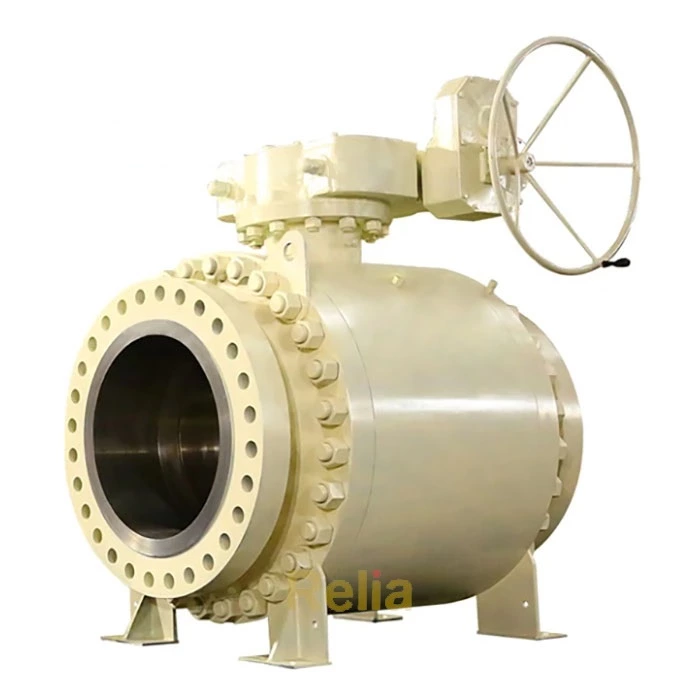Ball Valve Torque Chart
The ball valve torque chart contains basic information on determining the actued ball valve torques to be used for actuator selection. The torque values listed in the following tables are breakaway torques from the closed position.
Relia offers a valve actuation package fors, ball valves with pneumatic, electric and gas over oil operation.
Floating Ball Valve Torque Chart
| Size | Torque value (N.m) | ||||
| (inch) | Class 150 | Class 300 | Class 600 | Class 900 | Class 1500 |
| 1/2 | 12 | 17 | 30 | 38 | 51 |
| 3/4 | 14 | 23 | 38 | 56 | 130 |
| 1 | 27 | 48 | 66 | 98 | 238 |
| 1-1/2 | 55 | 89 | 120 | 189 | 350 |
| 2 | 75 | 100 | 160 | 240 | 550 |
| 2-1/2 | 125 | 141 | 233 | 390 | 980 |
| 3 | 162 | 216 | 308 | 610 | ... |
| 4 | 234 | 476 | 635 | ... | ... |
| 5 | 546 | 910 | ... | ... | ... |
| 6 | 804 | 1338 | 1944 | ... | ... |
Note:
- All ball valves are in normal temperature with PTFE seat for Class 150 and Class 300 ball valves and Nylon seat for Class 600 ball valve, PEEK seat for Class 900 and Class 1500 ball valves.
- Torque shown in this table is to be used as a guid for actuator selection, A safety factor of 1.5 times is recommended for sizing actuator.
- Torque may be changed according to different medium and trim material.
Trunnion Ball Valve Torque Chart
| Size | Torque value (N.m) | |||||
| (inch) | Class 150 | Class 300 | Class 600 | Class 900 | Class 1500 | Class 2500 |
| 1-1/2 | 40 | 50 | 80 | 130 | 240 | 290 |
| 2 | 50 | 70 | 120 | 180 | 250 | 380 |
| 3 | 60 | 100 | 240 | 400 | 530 | 780 |
| 4 | 100 | 210 | 500 | 670 | 900 | 1300 |
| 6 | 420 | 600 | 900 | 1820 | 2040 | 4850 |
| 8 | 700 | 1100 | 1500 | 2560 | 4790 | 6900 |
| 10 | 1100 | 1800 | 2750 | 4510 | 8230 | 13600 |
| 12 | 1600 | 2500 | 3600 | 6824 | 10340 | 23100 |
| 14 | 1950 | 3200 | 4700 | 8250 | 12123 | |
| 16 | 2500 | 3500 | 5470 | 9940 | 14920 | |
| 18 | 3400 | 5510 | 9000 | 14630 | 27230 | |
| 20 | 4600 | 7500 | 11000 | 20000 | 32830 | |
| 22 | 5200 | 9000 | 14630 | 25400 | 39420 | |
| 24 | 6774 | 11150 | 17950 | 29900 | 46320 | |
| 26 | 8000 | 13360 | 21640 | 34950 | 55430 | |
| 28 | 8600 | 14200 | 24340 | 38780 | 70650 | |
| 30 | 9223 | 16660 | 32510 | 46610 | 75000 | |
| 32 | 11810 | 19500 | 37600 | 58230 | ||
| 34 | 13330 | 21380 | 41800 | 63750 | ||
| 36 | 14214 | 29375 | 47570 | 72600 | ||
Note:
- The trunnion mounted ball valve torque value is calculated based on normal temperature.
- Torque shown in this table is to be used as a guide for actuator selection. A safety factor of 1.3~1.5 is recommended for actuator sizing.
- Torque may be changed depending on fluids and trim materials.
Breakaway torques are determined by measured after the valve has been in the closed position under pressure for a set time period, and are the highest torques expected. The running torque is approximately 50%, or one-half, of the breakaway torque. The re-seat torque is approximately 75%, or three-quarters, of the breakaway torque.
BTO - Break To Open
RTO - Run To Open
ETO - End To Open
BTC - Break To Close
RTC - Run To Close
ETC - End To Close

Relia Pneumatic Ball Valves
Factors Affecting The Torque Value
Seat Materials:
The ball seat materials used in a valve will significantly influence the operating torque. Softer, lower-friction seats (such as TFE or TFMTM) will have a lower torque than the harder, higher-friction materials such as Delrin or PEEK. Different tables have been provided where seat materials significantly affect operating torque.
Line Media:
What is flowing through the valve can have the most significant effect on valve operating torques. Fine solids, slurries, or very viscous fluids can have a great effect, not only on torque but also on valve service life. Media factors are also provided in the tables at the end of this bulletin.
Operation Frequency:
How the valve will be operated and how frequently it will be operated also affect actuator selection and torque. Infrequent operation will require higher torque values than for valves in modulating services, for example. Service factors are provided in the tables at the end of this bulletin.




